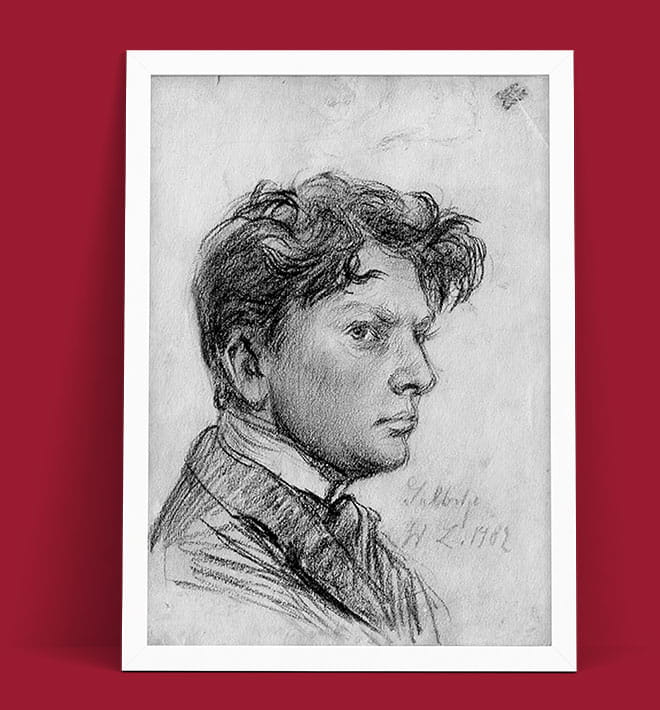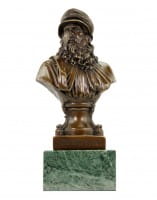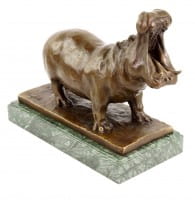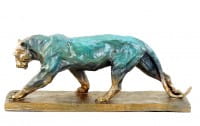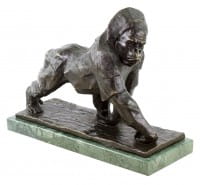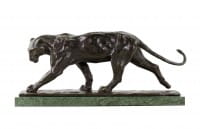Prices incl. VAT, free shipping worldwide
Ready to ship today,
Delivery time appr. 3-6 workdays










Product description
"Bronze Statue - Inclined Head of a Woman - Wilhelm Lehmbruck"
| Weight | 7,5 kg |
Inclined Silence – Wilhelm Lehmbruck’s 'Inclined Head of a Woman' - Signed
This evocative bronze sculpture, titled Inclined Head of a Woman, is one of the most stirring early works by Wilhelm Lehmbruck, the German expressionist sculptor who redefined the boundaries of modernist plastic art in the early twentieth century. Created in 1910, this tender yet monumental bust reveals Lehmbruck’s deeply emotional approach to figuration. It is signed W. Lehmbruck, affirming its authorship and artistic integrity. Cast in bronze, the material lends the sculpture a quiet dignity and solemn warmth, heightening the introspective mood of the figure. Her head gently inclines downward, the face a mirror of soft contemplation and inner life. The sculpture exudes both classical calm and modern psychological tension—a duality that marks much of Wilhelm Lehmbruck’s oeuvre.
A sculptor of quiet inwardness
Born on 4 January 1881 in Meiderich, today part of Duisburg, Wilhelm Lehmbruck grew up in the industrial Ruhr region. Despite this harsh environment, his artistic temperament gravitated toward spiritual depth, sensitivity, and idealized beauty. After studying at the Düsseldorf Academy of Arts and encountering Auguste Rodin’s work, Lehmbruck's own artistic language quickly evolved. By 1910, the year this sculpture was conceived, he had begun forging his unique expressionist voice, merging classical ideals with modernist abstraction. Inclined Head of a Woman clearly belongs to this crucial turning point. The piece was likely completed during his productive period in Düsseldorf or Paris, both cities where Wilhelm Lehmbruck refined his aesthetic vision.
A face shaped by empathy and introspection
The woman’s face, turned slightly and downward, appears withdrawn from the world—yet full of humanity. Unlike the cold idealism of Neoclassicism, Wilhelm Lehmbruck imbues the surface with expressive sensitivity. The subtle treatment of the brow, the closed eyelids, and the gentle curvature of the lips communicate something deeper than beauty: a profound stillness and sorrow. The armless bust removes all gesture except for that of the head itself, making the simple tilt more eloquent than any outstretched hand. This form does not shout—it meditates. In the silence of the sculpture, the viewer senses a quiet empathy with human suffering and inner longing.
Wilhelm Lehmbruck and the modern soul
At the heart of Wilhelm Lehmbruck’s art is an enduring commitment to the inner life. He rejected superficial realism and instead sought sculptural forms that could express the emotional and spiritual state of modern humanity. Inclined Head of a Woman is a masterful example of this endeavor. The absence of arms, the smooth surfaces, and the bowed head invite reflection on themes of humility, dignity, and vulnerability. Lehmbruck once said that “beauty is the expression of sadness,” and nowhere is that more palpable than in this haunting head. Rather than idealizing the female form as object, Wilhelm Lehmbruck presents it as a vessel of quiet psychological truth.
Timeless bronze, timeless emotion
The medium of bronze adds gravitas to the sculpture. Its warm tone, neither cold nor flashy, enhances the meditative aura. The bust’s surface captures light gently, allowing shadows to play across the curves of the cheekbones and collarbone. Unlike marble, which distances the viewer with its cool purity, bronze seems to breathe and feel. This tactile immediacy is vital to the emotional power of Inclined Head of a Woman. The choice of medium was intentional: Wilhelm Lehmbruck often used bronze to translate his quiet forms into permanent presence, and here, the metal becomes a skin for memory, mourning, and muted grace.
Expressionist restraint in the face of despair
By 1910, Wilhelm Lehmbruck had already begun to distance himself from the academic traditions of sculpture. Although trained in the classical manner, he forged a new mode of modernism rooted in psychological introspection and emotional intensity. Inclined Head of a Woman is not only a technical marvel of composition and balance, but also a deeply expressive work that transcends mere representation. The subdued features, the elongated neck, and the stylized shoulders reveal Lehmbruck’s gift for abstraction without abandoning figuration. His sculpture becomes a silent hymn to inner strength in the face of despair.
A symbol of a vanished world
Looking at this piece today, one cannot ignore its historical resonance. Wilhelm Lehmbruck created Inclined Head of a Woman during a brief period of artistic peace before the storm of the First World War. A few years later, the war would devastate Europe and plunge Lehmbruck into depression. He died by suicide in Berlin in 1919 at the age of just 38. In retrospect, the bowed head and solemn stillness of this bust seem tragically prophetic. It is a sculpture not only of a woman, but of a time quietly holding its breath. In this way, it becomes an icon of pre-war Europe’s lost innocence, distilled in bronze.
Where the sculpture lives on today
Today, Inclined Head of a Woman remains one of the most beloved works by Wilhelm Lehmbruck. It is part of the collection of the Lehmbruck Museum in Duisburg, a place dedicated to the preservation and celebration of his artistic legacy. The museum houses many of his finest sculptures, drawings, and prints, offering visitors an intimate view of his inner world. Standing before this bust, one is struck by its quiet eloquence and timeless modernity. Though over a century old, the sculpture speaks to contemporary audiences with undiminished force—a testament to the enduring relevance of Wilhelm Lehmbruck’s artistic vision.
A bronze whisper that endures
Inclined Head of a Woman is not loud. It does not seek to overwhelm. Instead, it listens, mourns, and breathes. It captures the essence of Wilhelm Lehmbruck’s artistry: sensitivity over spectacle, introspection over idealism, and spiritual depth over decorative flair. For collectors, curators, and admirers of early modern sculpture, this piece stands as a quiet masterpiece, whispering truths that words cannot fully reach. As long as bronze endures, so too will this eloquent gesture of human vulnerability—and with it, the enduring legacy of Wilhelm Lehmbruck.
Height 42 cm
Width: 40 cm
Depth: 23 cm
Weight: 7,5 kg
100% Bronze
Our advantages
free shipping
Worldwide free shipping
14 days money back
You can cancel your order
within 14 days
secure payment services
Paypal, Master Card, Visa, American Express and more

